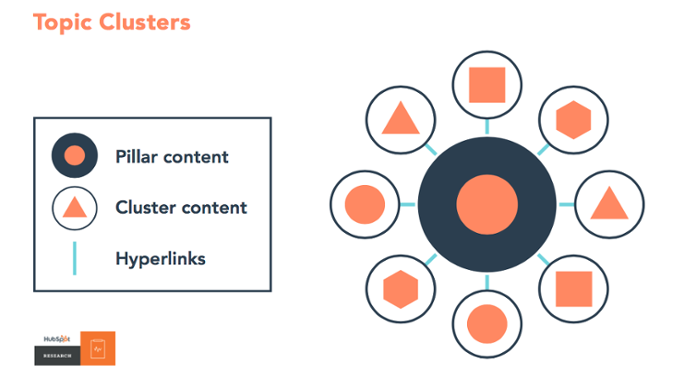Since April 2017, we have been offering a series of webinars with the experts of the HubSpot Marketing team: Inside HubSpot Marketing. As the year is coming to an end, we’ve compiled the most significant learnings from these masterclasses to help you plan for success in 2018.
Attract more visitors
If your goal next year is to supercharge your top of the funnel efforts, we are sure you will find the recommendations from Carly Stec, Editor for HubSpot’s Marketing Blog, really interesting.
Carly explained how HubSpot is rethinking content planning and distribution, and how are they using topic clusters to adapt to the new search paradigm.
The basic premise behind building a content program in topic clusters is to enable a broader coverage across a range of core topic areas while creating a compelling information architecture in the process.

The pillar content is the ‘source of truth’ for a specific topic, and it links to blog posts that cover more detailed and particular subtopics. These articles, also known as cluster content, link back to the core pillar and often in between other cluster content within the same topic. Altogether, they form a topic cluster.
Do you want to build your own topic clusters? Follow Carly’s process:
- Map out 5-10 of the core problems that your buyer persona has.
- Group each of the problems into broad topic areas.
- Build out each of the core topics with subtopics using keyword research.
- Map out content ideas that align with each of the core topics and corresponding subtopics.
- Validate each idea with industry and competitive research.
- Create, measure, and refine.
The next step to get more visitors for your company: leverage social media. Our expert Chelsea Hunersen gave us some insight on how to use social channels in 2017.
People have short attention spans, and we have to make sure we put effort into creating meaningful content to catch people’s attention.
How can you build a relevant social strategy?
- Build a Social Media Persona.
- Decide your goals (awareness, leads, traffic, support…) and start building a funnel towards them.
- Decide your metrics for success.
Chelsea also shared some findings when auditing HubSpot’s social strategy, and some useful tools to build and create content for your social networks.
If you want to amplify your reach in social media, then you should check Áine Devane’s webinar. Áine gave 10 insider tips to save money and generate more results with paid social media promotion.
Some of these recommendations included:
- Target lookalike audiences.
- Use Lead Ads (this format got HubSpot 77% cheaper leads).
- Use exclusions (they are as important as the audience you are actively targeting).
- Use Carousels.
Want to get the full list of recommendations?
> Register now and get access to all webinars
Generate more leads
If your focus in 2018 is increasing your database, then you should think about Co-Marketing as a great way to reach new audiences.
If you are not familiar with the term, co-marketing is when two or more companies collaborate in the creation and promotional efforts of a co-branded offer. HubSpot, for example, has launched co-marketing campaigns with companies like Citrix, LinkedIn, Prezi or Getty Images.
Which process do you need to follow if you want to create a co-marketing campaign?

(Bonus: Sióbhan McGinty's webinar included a link to a Trello Card for co-marketing project management)
Close more deals
Last, but not least, if you want to focus on nurturing and qualifying your database you should watch Éabhan Rowe’s session on Lead Nurturing, and Cambria Davies’ one on Lead Qualification.
Lead nurturing should move leads down the funnel, surface qualified demand and educate the prospect. To take on these goals, HubSpot uses different strategies and types of workflows that you can also replicate for your agency:
- Welcome email to set expectations, explain who you are, provide value and inform next steps.
- First conversion nurturing to convert leads into MQLs.
- Pools & Rivers to keep your database nurtured depending on their behaviour (if they convert to MQL, they pass to sales; if they don’t, they receive content offers).
- Re-engagement campaigns to have a healthy database.
On the other hand, Cambria shared how HubSpot doubled connect rates by eliminating vanity metrics and redefining MQLs.
If you too want to focus on getting better leads for your company:
- Map out all of your high-value actions (those that generate MQLs).
- Look at the lead score of the contacts created by each high-value action.
- Analyze the percentage of leads that close into customers for each of these sources.
- Prioritize these activities:
- Assign the highest quality leads to your sales reps.
- Assign the second highest quality leads to your BDRs.
- Assign the lower-intent actions to Marketing and nurture those contacts.

HubSpot managed to accelerate the middle of the funnel by relying on relevant workflows, leveraging Meetings & Messages and aligning sales and marketing goals.
On a final note, if you want to sell sales enablement as a service or want to learn more about sales enablement for your agency, you should check the tips Ben Cotton gave in his presentation.
Sales enablement is a strategic discipline that partners cross-functionally to help the sales organisation succeed. It enables sales reps by providing content, deal support, training, best practices, knowledge, tools and technology throughout the sales process.
You can get an inside look at HubSpot’s strategy and results in the webinar.
> Register now and get access to all webinars
Remember to register to get access to these webinars and upcoming ones. We will be kicking off 2018 season with a session on how to assess your database and keep it healthy! Stay tuned :)
